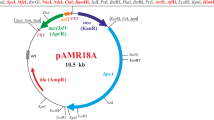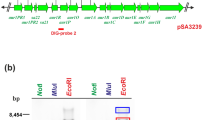Abstract
The bacteria of the genus Streptomyces are among the most important producers of biologically active secondary metabolites. Moreover, recent genomic sequence data have shown their enormous genetic potential for new natural products, although many new biosynthetic gene clusters (BGCs) are silent. Therefore, efficient and stable genome modification techniques are needed to activate their production or to manipulate their biosynthesis towards increased production or improved properties. We have recently developed an efficient markerless genome modification system for streptomycetes based on positive blue/white selection of double crossovers using the bpsA gene from indigoidine biosynthesis, which has been successfully applied for markerless deletions of genes and BGCs. In the present study, we optimized this system for markerless insertion of large BGCs. In a pilot test experiment, we successfully inserted a part of the landomycin BGC (lanFABCDL) under the control of the ermEp* promoter in place of the actinorhodin BGC (act) of Streptomyces lividans TK24 and RedStrep 1.3. The resulting strains correctly produced UWM6 and rabelomycin in twice the yield compared to S. lividans strains with the same construct inserted using the PhiBT1 phage–based integration vector system. Moreover, the system was more stable. Subsequently, using the same strategy, we effectively inserted the entire BGC for mithramycin (MTM) in place of the calcium-dependent antibiotic BGC (cda) of S. lividans RedStrep 1.3 without antibiotic-resistant markers. The resulting strain produced similar levels of MTM when compared to the previously described S. lividans RedStrep 1.3 strain with the VWB phage–based integration plasmid pMTMF. The system was also more stable.
Key points
• Optimized genome editing system for markerless insertion of BGCs into Streptomyces genomes
• Efficient heterologous production of MTM in the stable engineered S. lividans strain









Similar content being viewed by others
Data availability
The authors can confirm that all relevant data are included in the article and/or its supplementary information files.
References
Ausubel FM, Brent R, Kingston RE, Moore DO, Seidman JS, Smith JA, Struhl K (1995) Current protocols in molecular biology. Wiley, New York
Baltz RH (2016) Genetic manipulation of secondary metabolite biosynthesis for improved production in Streptomyces and other actinomycetes. J Ind Microbiol Biotechnol 43:343–370
Belknap KC, Cooper JP, Barth CJ, Andam CP (2020) Genome mining of biosynthetic and chemotherapeutic gene clusters in Streptomyces bacteria. Sci Rep 10:2003
Bibb MJ, White J, Ward JM, Janssen GR (1994) The mRNA for the 23S rRNA methylase encoded by the ermE gene of Saccharopolyspora erythraea is translated in the absence of a conventional ribosome-binding site. Mol Microbiol 14:533–545
Bilyk B, Horbal L, Luzhetskyy A (2017) Chromosomal position effect influences the heterologous expression of genes and biosynthetic gene clusters in Streptomyces albus J1074. Microb Cell Factories 16:5
Busche T, Novakova R, Al’Dilaimi A, Homerova D, Feckova L, Rezuchova B, Mingyar E, Csolleiova D, Bekeova C, Winkler A, Sevcikova B, Kalinowski J, Kormanec J, Rückert C (2018) Complete genome sequence of Streptomyces lavendulae subsp. lavendulae CCM 3239 (formerly “Streptomyces aureofaciens CCM 3239”), a producer of the angucycline-type antibiotic auricin. Genome Announc 6:e00103–e00118
Craney A, Hohenauer T, Xu Y, Navani NK, Li Y, Nodwell J (2007) A synthetic luxCDABE gene cluster optimized for expression in high-GC bacteria. Nucleic Acids Res 35:e46
Fu J, Bian X, Hu S, Wang H, Huang F, Seibert PM, Plaza A, Xia L, Müller R, Stewart AF, Zhang Y (2012) Full-length RecE enhances linear-linear homologous recombination and facilitates direct cloning for bioprospecting. Nat Biotechnol 30:440–446
Gust B, Challis GL, Fowler K, Kieser T, Chater KF (2003) PCR-targeted Streptomyces gene replacement identifies a protein domain needed for biosynthesis of the sesquiterpene soil odor geosmin. Proc Natl Acad Sci U S A 18:1541–1548
Hopwood DA (2007) Streptomyces in nature and medicine: the antibiotic makers. Oxford University Press, New York
Horinouchi S, Hara O, Beppu T (1983) Cloning of a pleiotropic gene that positively controls biosynthesis of A-factor, actinorhodin, and prodigiosin in Streptomyces coelicolor A3(2) and Streptomyces lividans. J Bacteriol 155:1238–1248
Huo L, Hug JJ, Fu C, Bian X, Zhang Y, Muller R (2019) Heterologous expression of bacterial natural product biosynthetic pathways. Nat Prod Rep 36:1412–1436
Jiang W, Zhao X, Gabrieli T, Lou C, Ebenstein Y, Zhu TF (2015) Cas9-Assisted Targeting of CHromosome segments CATCH enables one-step targeted cloning of large gene clusters. Nat Commun 6:8101
Kharel MK, Pahari P, Shaaban KA, Wang G, Moris C, Rohr J (2012) Elucidation of post-PKS tailoring steps involved in landomycin biosynthesis. Org Biomol Chem 10:4256–4265
Kieser T, Bibb MJ, Buttner MJ, Chater KF, Hopwood DA (2000) Practical Streptomyces genetics. The John Innes Foundation, Norwich
Knirschova R, Novakova R, Feckova L, Timko J, Turna J, Bistakova J, Kormanec J (2007) Multiple regulatory genes in the salinomycin biosynthetic gene cluster of Streptomyces albus CCM 4719. Folia Microbiol 52:359–365
Kormanec J, Rezuchova B, Homerova D, Csolleiova D, Sevcikova B, Novakova R, Feckova L (2019) Recent achievements in the generation of stable genome alterations/mutations in species of the genus Streptomyces. Appl Microbiol Biotechnol 103:5463–5482
Kormanec J, Novakova R, Csolleiova D, Feckova L, Rezuchova B, Sevcikova B, Homerova D (2020) The antitumor antibiotic mithramycin: new advanced approaches in modification and production. Appl Microbiol Biotechnol 104:7701–7721
Kouprina N, Larionov V (2008) Selective isolation of genomic loci from complex genomes by transformation-associated recombination cloning in the yeast Saccharomyces cerevisiae. Nat Protoc 3:371–377
Matsushima P, Broughton MC, Turner JR, Baltz RH (1994) Conjugal transfer of cosmid DNA from Escherichia coli to Saccharopolyspora spinosa: effects of chromosomal insertions on macrolide A83543 production. Gene 146:39–45
Matulova M, Feckova L, Novakova R, Mingyar E, Csolleiova D, Zduriencikova M, Sedlak J, Patoprsty V, Sasinkova V, Uhliarikova I, Sevcikova B, Rezuchova B, Homerova D, Kormanec J (2019) A structural analysis of the angucycline-like antibiotic auricin from Streptomyces lavendulae subsp. lavendulae CCM 3239 revealed its high similarity to griseusins. Antibiotics (Basel) 8:102
Mayer A, Taguchi T, Linnenbrink A, Hofmann C, Luzhetskyy A, Bechhold A (2005) LanV, a bifunctional enzyme: aromatase and ketoreductase during landomycin A biosynthesis. ChemBioChem 6:2312–2315
Mitousis L, Thoma Y, Musiol-Kroll EM (2020) An update on molecular tools gor genetic engineering of actinomycetes – the source of important antibiotics and other valuable compounds. Antibiotics (Basel) 9:494
Muth G, Nussbaumer B, Wohlleben W, Puhler A (1989) A vector system with temperature-sensitive replication for gene disruption and mutational cloning in streptomycetes. Mol Gen Genet 210:341–348
Myronovskyi M, Rosenkranzer B, Luzhetskyy A (2014) Iterative marker excision system. Appl Microbiol Biotechnol 98:4557–4570
Myronovskyi M, Brotz E, Rosenkranzer B, Manderscheid N, Tokovenko B, Rebets Y, Luzhetskyy A (2016) Generation of new compounds through unbalanced transcription of landomycin A cluster. Appl Microbiol Biotechnol 100:9175–9186
Novakova R, Núñez LE, Homerova D, Knirschova R, Feckova L, Rezuchova B, Sevcikova B, Menéndez N, Morís F, Cortés J, Kormanec J (2018) Increased heterologous production of the antitumoral polyketide mithramycin A by Streptomyces lividans TK24 strains. Appl Microbiol Biotechnol 102:857–869
Rezuchova B, Kormanec J (2001) A two-plasmid system for identification of promoters recognized by RNA polymerase containing extracytoplasmic stress response σE in Escherichia coli. J Microbiol Methods 45:103–111
Rezuchova B, Homerova D, Sevcikova B, Núñez LE, Novakova R, Feckova L, Skultety L, Cortés J, Kormanec J (2018) An efficient blue-white screening system for markerless deletions and stable integrations in Streptomyces chromosomes based on the blue pigment indigoidine biosynthetic gene bpsA. Appl Microbiol Biotechnol 102:10231–10244
Rigali S, Anderssen S, Naome QA, van Weyel GP (2018) Cracking the regulatory code of biosynthetic gene clusters as a strategy for natural products discovery. Biochem Pharmacol 153:24–34
Sekurova O, Schneider O, Zotchev SB (2019) Novel bioactive natural products from bacteria via bioprospecting, genome mining and metabolic engineering. Microb Biotechnol 12:828–844
Tocchetti A, Donadio S, Sosio M (2018) Large inserts for big data: artificial chromosomes in the genomic era. FEMS Microbiol Lett 365:fny064
Wang H, Li Z, Jia R, Yin J, Li A, Xia L, Yin Y, Müller R, Fu J, Stewart AF, Zhang Y (2018) ExoCET: exonuclease in vitro assembly combined with RecET recombination for highly efficient direct DNA cloning from complex genomes. Nucleic Acids Res 46:2697
Westrich L, Domann S, Faust B, Bedford D, Hopwood DA, Bechthold A (1999) Cloning and characterization of a gene cluster from Streptomyces cyanogenus S136 probably involved in landomycin biosynthesis. FEMS Microbiol Lett 170:381–387
Xu M, Wright GD (2019) Heterologous expression-facilitated natural products’ discovery. J Ind Microbiol Biotechnol 46:415–431
Zhang JJ, Yamanaka K, Tang X, Moore BG (2019) Direct cloning and heterologous expression of natural product biosynthetic gene clusters by transformation-associated recombination. Methods Enzymol 621:87–110
Acknowledgements
We are grateful to Andriy Luzhetskyy (Universitat des Saarlandes, Saarbrucken, Germany) for the cosmid H2-26 and the plasmid pUWLoriT, to Justin Nodwell (McMaster University, Ontario, Canada) for the plasmid pMU1s.
Funding
This work was supported by the Slovak Research and Development Agency under contract nos. APVV-15-0410 and APVV-19-0009, and by VEGA grant 2/0026/20 from the Slovak Academy of Sciences. The research leading to these results has received funding from the European Commission’s Seventh Framework Programme (FP7/2007-2013) under the grant agreement STREPSYNTH (project no. 613877). This work was co-funded by the Slovak Research and Development Agency under contract no. DO7RP-0037-12.
Author information
Authors and Affiliations
Contributions
JK conceived and designed research. DC, RN, BR, DH, BS, MM, LN, RN, LF, and RJ conducted experiments. LN, JC, JK, MM, DC and BR analyzed data. DC and JK wrote the manuscript. All authors read and approved the manuscript.
Corresponding author
Ethics declarations
Ethical approval
This article does not contain any studies with human participants or animals performed by any of the authors.
Conflict of interest
The authors declare no competing interests.
Additional information
Publisher’s note
Springer Nature remains neutral with regard to jurisdictional claims in published maps and institutional affiliations.
Supplementary Information
ESM 1
(PDF 1334 kb).
Rights and permissions
About this article
Cite this article
Csolleiova, D., Knirschova, R., Rezuchova, B. et al. An efficient system for stable markerless integration of large biosynthetic gene clusters into Streptomyces chromosomes. Appl Microbiol Biotechnol 105, 2123–2137 (2021). https://doi.org/10.1007/s00253-021-11161-w
Received:
Revised:
Accepted:
Published:
Issue Date:
DOI: https://doi.org/10.1007/s00253-021-11161-w




